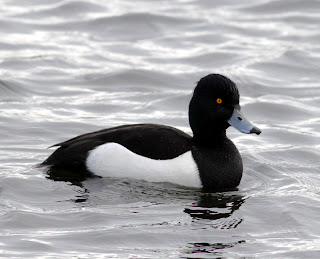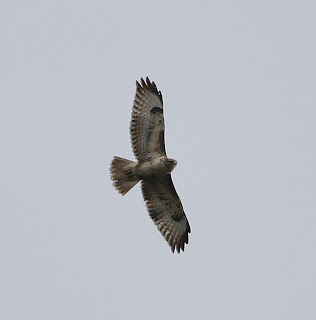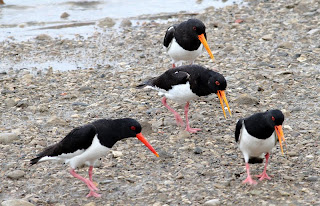I thought to have a change from ringing today even though Seumus and Ian were going to the Nature Park again. I didn’t relish another 5am start because these mornings invariably turn into much earlier wake ups when I can’t sleep for fear of missing an early alarm call. So I had a moderately early breakfast then set off towards Pilling and Conder Green for a little gentle birding, rather than the hard work of ringing. Driving through Stalmine and Pilling I noticed several groups of Swallows gathered on overhead wires, a sure sign of impending autumn with "hirundine mornings" or even whole days of migration.
I wasn’t the only one taking an early breakfast as near Lane Ends I spotted a Barn Owl surveying a field dyke the energy efficient way by fence hopping rather than flying along and over the ditch. It worked of course as clearly the Barn Owl knew this stretch, and within a couple of minutes of scrutinising the rank vegetation it pounced upon a Brown Rat or a vole. The owl flew off with the animal because in late July hungry young will be waiting for a meal. I was glad I’d eaten my breakfast; I certainly didn’t fancy what the owls had on offer.





At Conder Green the customary list ensued with 7 Common Sandpipers, 1 Spotted Redshank, 1 Wigeon, 1 Tufted Duck, 45 Redshank, 3 Curlew and 1 Grey Heron, but seeing the single Ruff made a change from the usual fare. There were lots of Lapwing on the pool, spooked by something unseen more than once before settling down again on the far islands where I estimated about 95 birds, plus 15 Oystercatchers dotted around.


Lane Ends proved typically Julyish, there were birds about but hard to see in the thick growth. I managed to find 2 Reed Warblers, 2 Willow Warblers and a Reed Bunting with 4 Pied Wagtails on the shore. Here I counted another 70 Lapwings scattered across the marsh plus 30 or so Curlews, with other small groups dropping in from inland fields. The pools held growing numbers of Mallards with 3 Tufted Duck.
The walk up to Pilling Water was deathly quiet with just a couple of Skylarks a single Meadow Pipit and near Pilling Water, 2 more Pied Wagtails, 6 Linnets, and over near the wildfowler’s pools, a Reed Bunting.
In the distance towards Fluke Hall I could see Swallows feeding low over the crops, difficult to count as they whizzed haphazardly over and through the fields, but I think a minimum of 120 birds. Now and then small groups gathered on the field boundaries and as the wind blew from the south it came with a distinct touch of autumn cool in the air.

Goodness me the forecast looks OK for the week ahead, ringing tomorrow and mid week!






























































.jpg)












